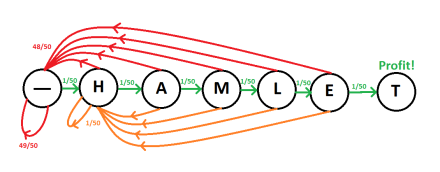As promised, today’s blog post is about the Surprise Test Paradox. A quick recap:
On Friday, a teacher says to their class that on some day during the next week, there will be a surprise test. However, the students make the following deductions:
- The teacher can’t wait until next Friday, otherwise the test won’t be unexpected, so a Friday test is impossible.
- Having eliminated Friday, Thursday is now the last possible day for the test to occur.
- Rinse and repeat. We eliminate all possible days of the week, so a surprise test is impossible!
However, the teacher sets a test on Wednesday, to the surprise of all the students.
Why did I put off this blog post, promising to talk about it some time before the New Year? To illustrate the paradox for real. Despite any readers of this blog being able to follow the same logic as the students, you had no idea when I was going to make this post. So is there a problem with the above logic?
What follows is heavily inspired by an excellent article written by Timothy Chow.
Essence of the Paradox
Here are a few observations which try capture some subtleties in the premise of the paradox.
In the story, the teacher sets the test on Wednesday. The choice of Wednesday isn’t important at all. Indeed, as soon as the students had convinced themselves that there would be no test, the teacher would have been able to surprise them on any day of the week. This doesn’t resolve the situation, in that it doesn’t find a flaw in the reasoning process. In fact, it’s wholly unsatisfactory. The correct reasoning of the students convinces them that no surprise is possible, which makes a surprise possible, somehow rendering their correct conclusion incorrect…
What the last paragraph does usefully illustrate is that ‘surprise’ might depend on all kinds of things, like the students’ current states of reasoning, as well as their knowledge of the teacher’s announcement. Surprise and knowledge are very vague and tricky concepts to try and pin down logically.
For example, we can blame the teacher for announcing the test to begin with. The implicit Step 0 in the student’s reasoning is their knowledge that a test will occur (even more than this, their trust in the teacher’s announcement).
The students’ argument also uses the fact that there is a ‘final day’ on which the surprise test can happen. If the teacher had merely promised them a surprise test in the future, there would be no paradox. Their reasoning would not make it past Step 1.
Resolution?
Two essential features of the paradox are the announcement of the test, and the fact that there is a “final day”. So let’s consider the simplest possible case (in fact, this is the case that the students arrive at):
On Friday, the teacher announces “There will be a surprise test on Monday!”
Of course, this statement is badly written. Most humans would probably now interpret the “surprise” as pertaining to the content or length of the test, rather than the day on which it was to be held, since the teacher has stated this. Slightly better:
On Friday, the teacher announces “There will be test on Monday. On Monday, the timing of the test will come as a surprise to you!”
Taken in the context of the original paradox, this statement is clearly absurd. It seems as though the teacher is at fault for giving the students a contradictory statement. We could say the same for the original. A precise way of reformulating the teacher’s announcement is:
On Friday, the teacher announces “There will be a test next week. It is not possible to deduce the day of the test from this announcement”
Self-reference. The teacher might as well have said “This is not an announcement”. Actually, you can go through the formal steps as Chow does, and phrase even this self-referential statement mathematically using Godel numbering and such things. The conclusion is still that the announcement is contradictary.
Conclusion
The self-reference argument is just about good enough for me. Reformulating the announcement seemed to clear things up quite a lot. But unfortunately, the teacher’s statement is justified undeniably after the fact, logically ridiculous until it comes true. Isn’t this as bad as our observation before, with the correct reasoning of the students becoming incorrect only later?
There is no universally accepted resolution to the surprise test paradox. But that’s the one that I like the best.













